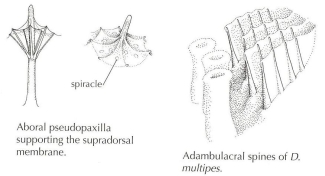Family Description:
The aboral side of body is inflated and the oral side flat. A supra dorsal membrane supported by the spines of the paxillae covers the true aboral surface to create a nidamental chamber. In the centre of this membrane is a large opening (osculum). Many smaller spiracles pierce the rest of the membrane. On each side of the ambulacral furrow is a wide actinolateral membrane supported by long spines; between the spines are small holes, each guarded by an operculum, which lead to the nidamental chamber; water enters here and is expelled through the osculum. No oral intermediate plates.
